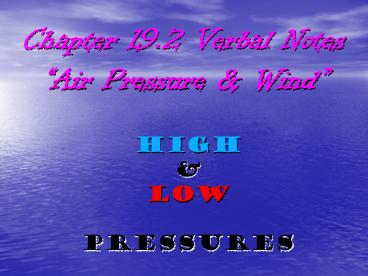Chapter 19.2 Verbal Notes - PowerPoint PPT Presentation
1 / 20
Title:
Chapter 19.2 Verbal Notes
Description:
... differences of unequal heating by acting as a giant heat-transfer system. ... model, the two-cell convection system would break down into smaller cells. ... – PowerPoint PPT presentation
Number of Views:93
Avg rating:3.0/5.0
Title: Chapter 19.2 Verbal Notes
1
Chapter 19.2 Verbal Notes Air Pressure Wind
High Low Pressures
2
Pressure Centers and Winds
- Cyclones are centers
- of low pressure.
- (storms occur here)
- Anticyclones are
- centers of high
- pressure.
- ? In cyclones, the pressure decreases from the
outer isobars toward the center. In anticyclones,
just the opposite is the casethe values of the
isobars increase from the outside toward the
center.
3
How are weather maps made?
- In cyclones, (L) the pressure decreases from the
outer isobars toward the center. - In anticyclones, (H) just the opposite is the
casethe values of the isobars increase from the
outside toward the center.
4
Pressure Differences
- Low Pressure system air coming up either cloud
cover and precipitation or no clouds because no
moisture - High pressure system air coming down generally
fair skies
5
Wind and Pressure Relationships
950 mb.
970 mb.
960 mb.
930 mb.
H
L
- WINDS ALWAYS MOVE FROM HIGH PRESSURE AREAS TO
LOW PRESSURE AREAS!!!!!!!
6
Cyclonic and Anticyclonic Winds
- When the pressure gradient and the Coriolis
effect are applied to pressure centers in the
Northern Hemisphere, winds blow - Counterclockwise around a low pressure area
- Clockwise around a high pressure area
7
Cyclonic and Anticyclonic Winds
8
Pressure Centers and Winds
? Weather and Air Pressure
Rising air is associated with cloud formation
and precipitation, whereas sinking air produces
clear skies.
? Weather Forecasting
Weather reports emphasize the locations and
possible paths of cyclones and anticyclones.
Low-pressure centers can produce bad weather
in any season.
9
Global Winds!
10
Global Winds
? The atmosphere balances differences of unequal
heating by acting as a giant heat-transfer
system. This system moves warm air toward high
latitudes and cool air toward the equator.
11
Non-Rotating Earth Model
- On a hypothetical non-rotating planet with a
smooth surface of either all land or all water,
two large thermally produced cells would form.
12
Circulation on a Non-Rotating Earth
13
Rotating Earth Model
If the effect of rotation were added to the
global circulation model, the two-cell convection
system would break down into smaller cells.
14
WIND BELTS
- Trade winds are two belts of winds that blow
almost constantly from easterly directions and
are located on the north and south sides of the
subtropical highs. - Westerlies are the dominant west-to-east motion
of the atmosphere that characterizes the regions
on the poleward side of the subtropical highs.
15
WIND BELTS
- Polar easterlies are winds that blow from the
polar high toward the subpolar low. These winds
are not constant like the trade winds. - A polar front is a stormy frontal zone separating
cold air masses of polar origin from warm air
masses of tropical origin.
16
Circulation on a Rotating Earth
17
Global Winds Influenced by Continents
The only truly continuous pressure belt is the
subpolar low in the Southern Hemisphere. In the
Northern Hemisphere, where land masses break up
the ocean surface, large seasonal temperature
differences disrupt the pressure pattern.
18
Global Winds Influenced by Continents
Monsoons are the seasonal reversal of wind
direction associated with large continents,
especially Asia. In winter, the wind blows from
land to sea. In summer, the wind blows from sea
to land.
19
Monsoon Photos
Click here to learn more about monsoons
20
Identify the Wind Belts
Click on the link below to see the wind belts in
action and answer some questions!
http//meted.ucar.edu/hurrican/strike/orig/htc5_1
.htm































